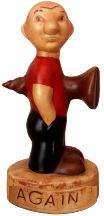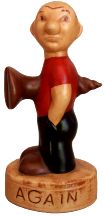 |
 The Virtual Corkscrew Museum's Daily Newspaper |
 |
 |
 The Virtual Corkscrew Museum's Daily Newspaper |
 |
|
Friday, February 6, 2004 |
Part 1 of 3 parts
Who Invented the Crown Cap Lifter?
The Crown Cork
Wirtz, Virginia - On this date in 1894 William Painter received a patent for a "Capped Bottle Opener." Two years earlier Painter had received three patents for a "Bottle Sealing Device." Prior to his 1892 invention, over 1500 types of bottle stoppers had been patented. Between 1882 and 1890 alone there were three hundred and thirty-seven stopper patents. The trade press was writing "it is pretty hard to get up anything in the stopper line which is not already covered."
Painter accepted the trade press challenge with "The only way to do a thing is to do it." Painter had over eighty patents to his credit in his lifetime including improvements on a shoe blacking box, a lamp, and numerous pump and valve patents. He began his work on the "crown cap" in 1889 and in the end his success was certainly a lasting one. The crown cap became a mainstay in the bottling industry for generations to come. His design prevailed over the hundreds of other bottle closures and his crown cap is known and used worldwide.
Here are two of his "Bottle Sealing Device" patents issued February 2, 1892:
U. S. Patent No. 468,226
U. S. Patent No. 468,258
Although the patent on the left has a lower number, the application was filed almost one year after the one on the right (May 19, 1891 vs. June 18, 1890). The earlier application includes a drawing of the cap being engaged by an over-the top style cap lifter
and states that the cap has "the edge of the flange so projected as to afford a reliable shoulder, with which a detaching lever may be engaged, for enabling a cap to be promptly removed as a result of a prying or wrenching action."
Three pages later in his application, Painter writes "It will be obvious that while some special form of opener may be required for detaching caps with the greatest possible convenience any thin-edged tool or knife may be readily applied to the projecting edge for detaching the cap, and to provide for use of a corkscrew each cap is centrally perforated at the top, enabling a corkscrew to better the sealing disk or cork."
He also hints at what is to come with "Bottle openers devised by me...and adapted to the removal of sealing-caps...will be made the subject of one or more separate applications for Letters Patent."
In the second application, Painter outlines more tools for removing his crown cap: "I have now so devised my loopless and close-topped caps and have so organized a combination thereof with the bottles that the caps can be almost readily detached by the use of a knife, a screw-driver, a nail, an ice-pick, or any usually and readily available pointed instrument as if a special opener were used, the latter being, of course, always preferable when bottles are required to be opened rapidly."
So Painter has now given the world his crown cap. It could be removed by a number of methods he described and all would have to wait for his further ideas on the "bottle opener."
_____________________________________________
Tomorrow in Part 2: Painter's "Capped Bottle Opener."
Another Corkscrew Murder
As reported in the Scotland's Daily Record by John Naylor
I Killed My Hubby with Corkscrew
Court told of couple's hotel bondage session
A SCOTS woman killed her husband with a corkscrew during a bondage session, a jury heard yesterday. Philip Croydon, 49, was found naked and bound at the wrists with 22 stab wounds in a hotel room. Three of the wounds were gaping cuts in his neck and chest.
Carol Croydon, 37, confessed to a childhood friend she had killed him, Nottingham Crown Court was told. Eileen Walker, of Renfrew, said Croydon who she had visited in jail told her: ''It was me. I stabbed him.''
Eileen asked what Croydon had used, and she replied: ''A corkscrew.''
Croydon denies murdering her husband, a furniture factory owner.
The court had earlier heard Croydon, of Edwins to we, Nottinghams hire, stood to inherit her husband's estate, including the £395,000 family home. His body was found at Hilton East Midlands Airport Hotel at Keg worth, near Nottingham, last April. The jury was told he'd been stabbed in a ''frenzied and brutal attack''.
Detective Constable Paul Wilkinson said Croydon, an accountant, claimed a couple called Brian and Linda were in the room for a swingers party but she had later left the hotel. However, later she claimed her secret lover Nelson Bland, a schoolteacher and councillor, came into the room and committed the murder.
Eileen said she had first met Croydon when the accused was two and living at Quarriers Children's Home. She was fostered into Eileen's family in Renfrew when she was 11 or 12. Eileen said she asked why she had killed Philip and Croydon replied that her husband was becoming like her first husband who she had divorced. Eileen's daughter Leslie, 33, of Renfrew, said Croydon claimed her late husband had raped her.
Prison officer Deborah Lamb also told the court Croydon said: ''I did it. I killed my husband. I can see his face. I can see his face.'' The trial continues.
|
©2004 Don Bull, Editor |